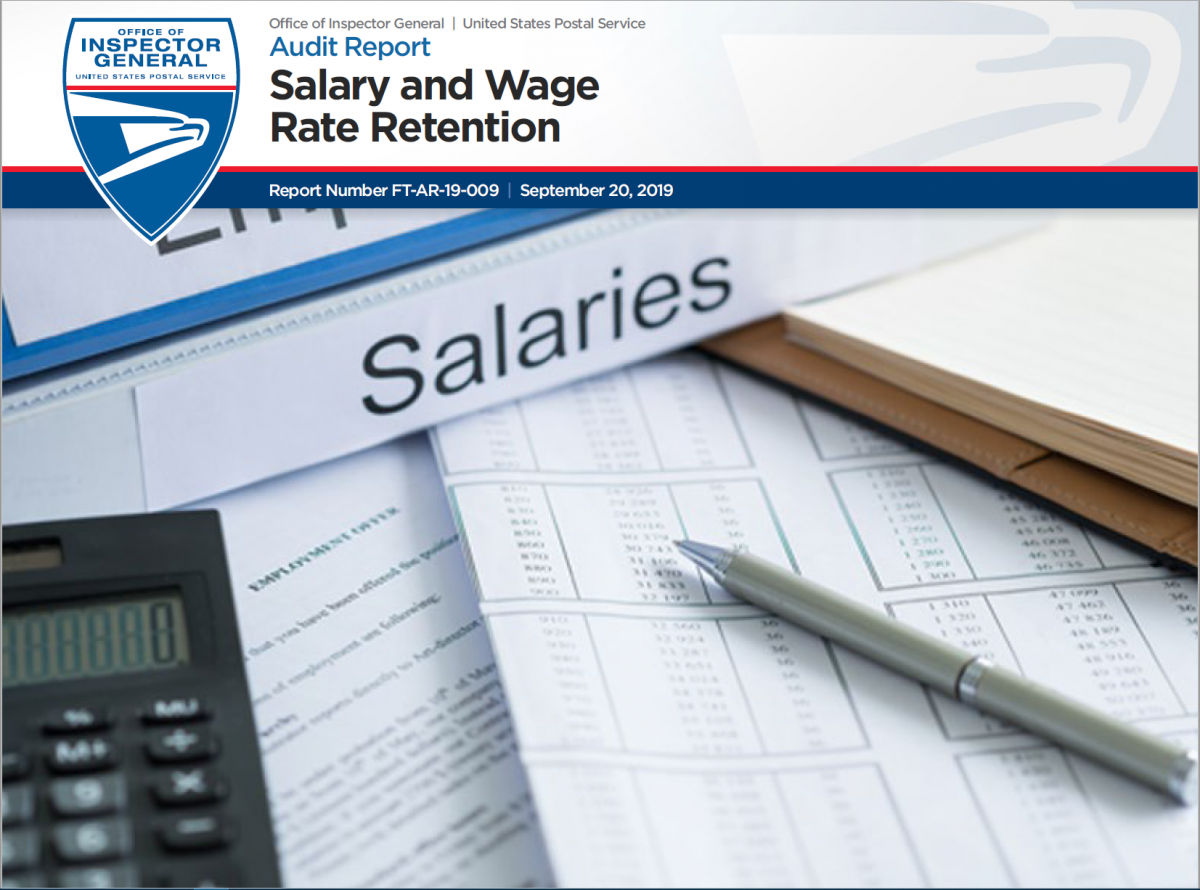Objective
U.S. Postal Service pay administration policies establish conditions and procedures for setting the salaries of Postal Service employees. Salary and wage rate retention provisions exist for employees involuntarily assigned to lower pay grade positions due to management action. The three rate retention types are:
- Saved grade – an employee receives saved grade status when a management action eliminates their current position.
- Saved rate/saved salary – an employee receives saved rate or saved salary status when a management action changes their job ranking or classification.
- Protected rate – similar to saved rate but limited to two years.
There are separate salary and wage rate retention provisions for bargaining and nonbargaining employees.
We initiated this audit based on analytic procedures performed on payroll systems data to determine the number of employees with salary and wage rate retentions. The analytics disclosed that the Postal Service had 4,554 employees as of November 24, 2018, with salary and wage rate retentions for more than two years, including 3,946 bargaining and 608 nonbargaining employees.
Our objective was to determine whether the Postal Service properly assigns and manages salary and wage rate retention for employees assigned to lower grade positions.
What the OIG Found
The Postal Service did not always properly assign and monitor salary and wage rate retentions for employees involuntarily moved to lower grade positions. Management maintained Postal Service (PS) Forms 50, Notification of Personnel Action, electronically; however, PS Form 50 does not include source documentation for the management action. We requested further supporting documentation, but management did not always provide additional support.
Specifically, we statistically selected 203 employees (184 bargaining and 19 nonbargaining) from a universe of 8,965 employees with rate retentions as of March 16, 2019. We judgmentally selected five additional employees (two bargaining and three nonbargaining) to ensure coverage of all rate retention classifications. Of the 208 employees reviewed, management:
- Responded but did not provide documentation other than a PS Form 50 in some cases to support employee salary and wage rate retentions for 104 of the employees (50 percent).
- Did not respond or provide any documentation to support rate retentions for 29 employees (14 percent).
- Responded and provided support, such as memorandums of understanding, settlement agreements, and employee notifications for the remaining 75 employees (36 percent).
Further, we accessed PS Forms 50 for all 208 employees sampled to determine whether they contained information to support assigning employee salary and wage rate retentions. We reviewed the comments section for information on the rate retention and found that:
- Fifty-six (27 percent) did not have any comments regarding assignment of the rate retention.
- Seventy-eight (38 percent) referred to the assignment of the rate retention but did not have a description of management action initiating the rate retention, the duration of the rate retention, or were missing both.
- Sixty-seven (32 percent) did not include requirements for employee continued eligibility. Some of the forms were also missing a description of management’s action or the duration of the rate retention, as described in the preceding bullet.
- Sixty-eight (33 percent) had information that sufficiently described the assignment and employee continued eligibility requirements.
- Properly documenting rate retentions substantiates accountability and improves accuracy and timeliness of rate retentions. Because PS Forms 50 did not include all the supporting information needed, we were unable to determine proper rate retention assignments. Improper rate retention assignments may result in overpayment to employees.
We also found that management did not always monitor employee eligibility for salary and wage rate retention. Headquarters management stated that district level employees were responsible for monitoring rate retentions. However, when we inquired with personnel at seven district Human Resources offices we found that:
- None of the seven offices monitored rate retentions or continued employee eligibility.
- Two offices indicated monitoring may be done at the field level even though headquarters management stated that district-level employees were responsible for monitoring rate retentions.
- One employee advised that they used data from WebCoins to compare salary and job level information. WebCoins is a web-based tool for managing and tracking complement information about employees. The employee used the system to identify who had rate retentions.
- Four of the seven district Human Resources managers did not know how many employees had rate retentions.
The Postal Service did not have policies and procedures for documenting, retaining information, and monitoring management action, duration, or continued eligibility requirements for employee salary and wage rate retention. As a result, the risk of overpayment to employees no longer eligible for the salary and wage rate retention increases. Because management did not monitor rate retentions, we questioned nearly $8.5 million annually in salary differences between the saved grade level and lower job level.
As a result of our audit, management determined that 14 employees currently receiving rate retentions or higher-level salaries were no longer eligible. As of August 9, 2019, management completed the rate retention removal process for one employee and another has since retired.
What the OIG Recommended
We recommended management:
- Develop policies and procedures, including assignment of responsibilities, for documenting and retaining salary and wage rate retention information and monitoring continued eligibility.
- Develop and implement a plan to periodically identify and address employees no longer eligible for salary and wage rate retention status.
Read full report
Source: USPS Office of Inspector General

